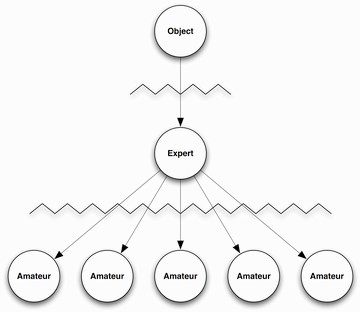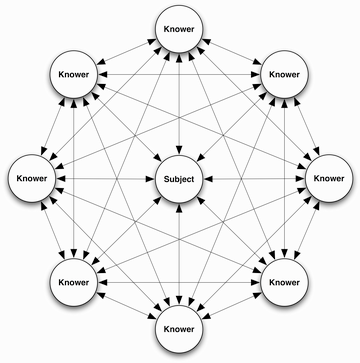I just listened to an episode of EdTech Chat on BAM! Radio from 10-7-13 titled “Finding a Framework for Transitioning to Digital Learning.” The topic remains timely in the field of education and in my world in particular.
The 14 minute show is packed with wonderful tidbits and quotes I wanted to share. Taking place in the discussion are Pam Moran (@pamoran), Mary Ann Wolf (@maryannwolfed), Glenn Kleiman (@gkleiman2), and Tom Murray (@thomascmurray).
I won’t regurgitate the transcript but here are a few of the questions posed and some gems that hit home.
How do we go about transforming the traditional classroom so that we can prepare students for their future and not our past?
How can school districts implement professional development so that we can get our teachers to the point where they need to be?
What does professional development need to look like to transform the teachers’s instruction to ultimately help kids?
I particularly like the discussion about the responsibility of the school district and school in the process. Partially related to the providing of the training but especially when it comes to making the expectations clear. Those expectations need to go beyond boxes on an evaluation rubric.
Mary Ann brought up the “importance of both formal and informal professional learning opportunities for educators.” Teachers in her district are given structured pieces via a MOOC but are also given the ability to be self-directed. It’s important to meet teachers where THEY are and give them access to professional learning that they can get the competencies that they need. “It’s really important that we make sure that teachers know about and have access to professional learning that really is personalized for them too.” Pam Moran added that MOOCs, PLCs, PLNs, and flipped staff meetings give teachers lots of opportunities to see where they are heading so they know what THEY need to learn to meet expectations.
“The one-size fits all is no longer working. Doesn’t work for kids and it certainly doesn’t work for teachers as well. Districts spend a lot of time preaching differentiation for kids but then often turn around and do the exact opposite for their own staff members.” – Glenn Kleiman
Teachers are learners just like students are learners and they’re going to learn differently so how do we help them design their own roadmaps?
How can a digital classroom transform teaching and learning? Glenn shared that “the tools we now have make it so much more feasible to personalize learning.” Pam stressed that we need to step away from “the Gutenberg Model of ‘write it, print it, read it, recall it, listen to it’ to a ‘search, connect, communicate, make’ post-Gutenberg model.

After searching a little bit about concepts related to Pam’s statement, I came across these two diagrams of the relationship of teacher and learner and subject. (source) They are derived from “The courage to teach : exploring the inner landscape of a teacher’s life” by Parker J. Palmer.
The traditional paradigm of “sage on the stage” is one with which we are all too familiar:

The environment we must embrace (and one that is so much more dynamic and inspiring) looks more like this:


I followed that reading by listening to the EdTech Chat podcast “Using Technology to Personalize Professional Development,” the episode with my fellow GTA Shaelynn Farnsworth (@shfarnsworth). Shaelynn, Tom Murray, and Sharon Plante have a refreshing conversation that I think captures concepts related to the needed paradigm shift for professional development. We have to move toward personalized learning for teachers that is not related to required hours of training but focuses on the outcome, the learning. Here are two great quotes from Tom:
“I don’t care what you attended. I care what you learned.”
“It’s really interesting how we traditionally herd teachers like cattle into large group rooms, we talk at them for two hours, and then we call it ‘professional development.'”
In addition to discussing various technology tools (Twitter, Edmodo, Google+), I liked the information about the EdCamp model (bottom-up) for PD as opposed to the traditional top-down, one-size-fits-all approach. A big part of that shift involves the district taking the planning for PD out of the hands of a few key people and move it to a shared learning experience. Shaelynn brings up the work of Dan Lortie and the term “apprenticeship of observation.” This refers to the tendency of teachers to revert back to how they were taught when the training they have received is lacking in some way. So, if district and school leaders want teachers to educate our students in a more differentiated way, those leaders need to model that in the professional development provided.
The conversation closed with talking about how to make this happen fed right into my philosophy of PD. Find the opportunities for yourself and don’t wait for your school or district to provide them for you.
“Teachers are passionate and they want to improve their own practice for student learning, they want to reflect upon it, and they want to share it and grow. – Shaelynn Farnsworth
“We need a culture shift in schools, we need to develop systemic approaches that are modeled by our administrators, that are not top-down, which cultivate teacher leadership.” – Tom Murray

As I continue to research my proposed dissertation topic (the impact of informal professional learning on counteracting teacher burnout) and work on my GTA innovation project (giving teachers and parents tangible, bite-sized steps to take in order to give children more ownership of their learning), I will be exploring these concepts in much more detail and will share my reflections here.




